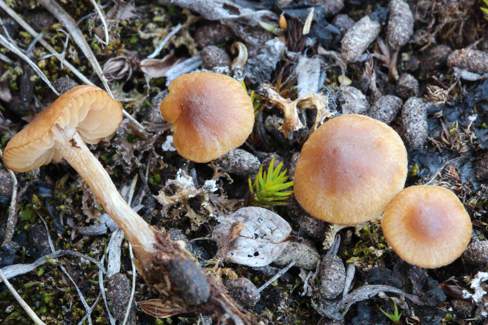 Hebeloma grandisporum (Photo: H. J. Beker)
Hebeloma grandisporum (Photo: H. J. Beker)Taxonomy
Full name: Hebeloma grandisporum Beker, U. Eberh. & A. Ronikier, Mycologia 107 (6): 1293 (2015)Genus: Hebeloma
Section: Hebeloma
Subsection: 'subsect1'
Types: ROMANIA: Southern Carpathians, Muntii Fagarasului, upper part of the valley Valea Podragului (towards the Saua Podragului pass) (45.6047°N, 24.6883°E, alt. approx. 2270 m a.s.l.) in alpine meadow under Salix retusa, 25 Jul. 2006, M. Ronikier, A. Ronikier (Holotype. herbarium acc. no. KRAM F-47189, HJB13114).
- arrow_drop_downarrow_drop_upEtymologyFrom grandis– large and sporus– spored. This is the Hebeloma species with the (on average) largest spores we have ever seen.
- arrow_drop_downarrow_drop_upDiagnosisHebeloma grandisporum belongs to H. sect. Hebeloma based on the presence of a cortina and the lageniform or ventricose cheilocystidia. It has consistently two-spored basidia and large amygdaloid and limoniform spores (ave. 15.4 × 8.9 µm), which are strongly dextrinoid. The ITS of the species is distinct from ITS sequences of all known species of Hebeloma from Europe.
References
Description
- arrow_drop_downarrow_drop_upThresholds
Description of Hebeloma grandisporum based on 5 collections
- arrow_drop_downarrow_drop_upMacroscopic descriptionPileus: 7–9 (10) mm diameter; shape umbonate; characters Not recorded; margin characters smooth; viscosity tacky when moist; colour variation often unicolour or two color; colour at centre clay-buff.
Lamellae: attachment Not recorded; maximum depth not recorded; number of complete lamellae 18–28; presence of tears absent; white fimbriate edge often present, occasionally weak.
Cortina presence: yes.
Stipe: 12–15 (17) x 2 {median} x 2 {basal} mm; stipe Q 6.0–8.5; base shape cylindrical; floccosity often fibrillose or pruinose; rooting Not recorded; thick rhizoids at base Not recorded;
Context: Texture firm; stipe interior Not recorded; stipe flesh discolouring no; slenderness measure 9.6–13.5; smell often odourless; taste Not recorded.
Spore deposit colour: Not recorded.
Exsiccata characters: Not recorded.
- arrow_drop_downarrow_drop_upMicroscopic descriptionSpores: shape amygdaloid, usually limoniform; colour in microscope often yellow brown, occasionally brown pale; guttules often no, occasionally weak. papilla usually yes, occasionally very strongly; Spore Code: O1 O2; P0; D2 D3.
Basidia: 23–43 (44) x 6–10 μm; ave. Q 3.1–4.3; spore arrangement 2 spored;
Cheilocystidia: main shape lageniform or ventricose, occasionally clavate-lageniform or clavate-ventricose; special features observed often septa, occasionally basal thickening or geniculate; cheilocystidia ratios: A/M = 1.02–1.44; A/B = 0.53–0.75; B/M = 1.48–2.03.
Pleurocystidia: none seen.
Ixocutis: epicutis thickness (measured from exsiccata) up to 130 μm; ixocutis hyphae width up to 6 μm; ixocutis hyphae encrustation variable; shape of trama elements beneath subcutis isodiametric up to 15 μm wide.
Caulocystidia: Similar to cheilocystidia but larger, up to 120 μm.
- arrow_drop_downarrow_drop_upSpore measurements
- arrow_drop_downarrow_drop_upCheilocystidia measurements
- arrow_drop_downarrow_drop_upHabitat and distributionHebeloma grandisporum's preferred habitat appears to be arctic tundra or arctic fenland with mossy soil. Across our collections, Hebeloma grandisporum has only been recorded as associating with Salix (family Salicaceae). The growth habit of our collections was often scattered or solitary.
According to our current collections, the species is predominantly found in Northern America (80.0%) but also found in Europe (20.0%). On these continents, collections has been found in the WWF biomes The World Wildlife Fund (WWF) have divided the world into 867 terrestrial ecoregions. The ecoregion here is estimated by mapping from the GPS coordinates of the collection using data made available by Dinerstein et al (2017). Use this webtool to explore the ecoregions visually or see a full list of current ecoregions on Wikipedia. tundra (80.0%) and temperate conifer forests (20.0%), specifically including the ecoregions: Canadian Middle Arctic Tundra (40.0%), Kalaallit Nunaat Arctic steppe (40.0%) and Carpathian montane forests (20.0%). From collector information, it appears collections have been found in the 4.1 Grassland – Tundra (60.0%), 5.11 Wetlands (inland) – Alpine wetlands (inc. temporary waters from snowmelt) (20.0%) and 5.10 Wetlands (inland) – Tundra wetlands (inc. pools and temporary waters from snowmelt) (20.0%) IUCN habitats We map from the collector's description of the habitat to the International Union for Conservation of Nature (IUCN)'s definition using a standardised set of rules. Please see this page for a full list of IUCN habitats..
Within Northern America all our records are from Subarctic America (Nunavut and Greenland).
Within Europe all our records are from the Southeast (Romania).
- arrow_drop_downarrow_drop_upMolecular resultsThe molecular results for this species, for which we have only a single collection, are divided: In the results of the mitochondrial loci and for RPB2 the sequences of H. grandisporum are hardly diverged from what one might call the ‘default’ for H. sect. Hebeloma. In contrast, the ITS of H. grandisporum (like those of H. cistophilum and H. sordescens) is very different from all other H. sect. Hebeloma species. Similarly, the Tef1a sequence of H. grandisporum is clearly different. In the five-locus tree H. grandisporum is also clearly in an isolated position. We are not aware of any other ITS sequence that is likely to belong to this taxon.
- arrow_drop_downarrow_drop_upCommentaryWith the persistent presence of a cortina and the lageniform or ventricose cheilocystidia, this taxon clearly belongs in H. section Hebeloma. Within this section, it can be differentiated on the basis of the very large amygdaloid and limoniform spores, distinctly to rather strongly dextrinoid. It is the only Hebeloma collection we have ever encountered where all basidia appear to be two-spored, which no doubt contributes to the large spore size. The only other Hebeloma spp. with almost as large spores are H. ammophilum and H. nauseosum. Unfortunately, we only have a single collection of H. grandisporum and no photograph or full macroscopic description of fresh material. However, this taxon is very distinctive both microscopically and molecularly.
Geographic distribution












Phenology
- arrow_drop_downarrow_drop_upAdditional cited collections